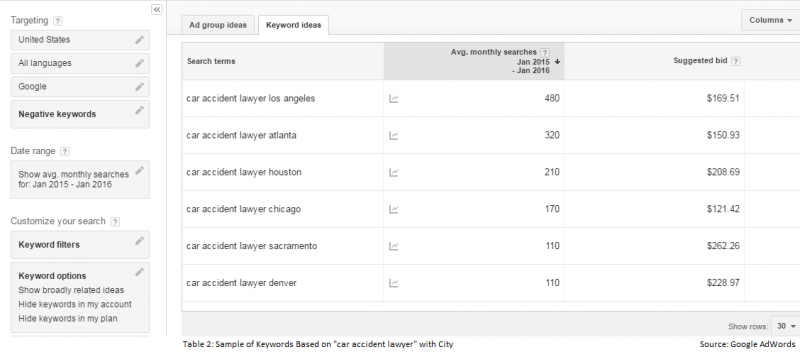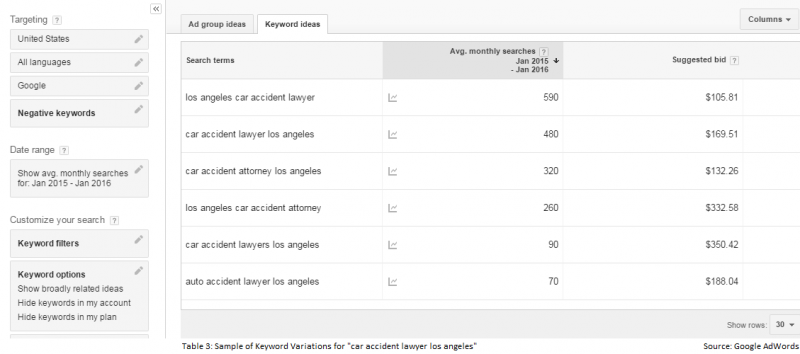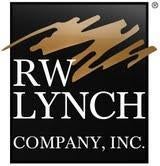PPC Advertising & Personal Injury Campaign Costs
Pay-per-click (PPC) advertising campaigns are priced on a cost-per-click (CPC) basis, which means that you are only charged when someone clicks on your PPC ad. It is worth noting that while PPC campaigns are only charged on a per click basis, campaign pricing is set up on a daily/monthly limit (e.g., if you place a $50 per day limit, it translates to about a $1,500 monthly PPC advertising cost). So how do you figure out the costs associated with a PPC advertising campaign? Well, there are a number of variables that impact the overall campaign costs and lead generation efforts that we’ll cover below.
Personal Injury PPC Keyword Bids & Competition
PPC advertising pricing, or cost per click, is determined by placing a bid on a particular keyword or string of keywords. While you can place any bid amount, if it is not competitive enough, your ad will not show up in the advertising spots available on each search engine results page (SERP). The number and location of PPC advertising spots varies by search engine. Google, which is the most prominent search advertising company, has only seven advertising spots available on each page: four on the top of the SERP and three on the bottom.
Competitive pricing for PPC advertising campaigns varies significantly by industry, but legal advertising is the most expensive. And when you focus in on personal injury keywords, placing a competitive keyword bid becomes much more expensive. In the example below (Table 1), “lawyer,” “personal injury lawyer” and “car accident lawyer” are all compared using Google AdWords. While the broad keyword search term “lawyer” has a suggested bid of $8.35 per ad click, the term “personal injury lawyer” jumps up to a suggested bid of $102.70 and “car accident lawyer” to $143.94.

Local Personal Injury PPC Campaigns & Bid Price
While the above reference gives an idea of competitive bid prices and the potential cost-per-click (CPC) associated with general personal injury keyword search terms, broad national PPC campaigns are not effective for law firms that have a single location or are regionally located. Local PPC advertising campaigns are critical for law firms trying to generate personal injury leads in the areas they serve, and competitive keyword terms can vary significantly by geographic area. In the example below (Table 2), there is a list of six search terms in Google AdWords based on “car accident lawyer” that is qualified by a city. This range includes a low suggested bid of $121.42 for “car accident lawyer chicago” and a high suggested bid of $262.26 for “car accident lawyer sacramento.”

Personal Injury Keyword Variations & Costs
PPC ads are displayed when a particular keyword search is conducted. In the Table 2 reference above, you will notice that the more targeted a keyword search term, such as “car accident lawyer los angeles,” the less average monthly searches that occur. For this case, roughly 480 “car accident lawyer los angeles” searches are conducted per month. In order to get enough PPC advertising exposure, which are referred to as “impressions,” PPC campaigns are structured around variations of a keyword or keywords in order to account for different search behavior and increase the chances of being displayed when a relevant search is conducted.
In the example below (Table 3), there are six potential variations of the keyword phrase “car accident lawyer los angeles.” Depending on the exact keyword phrase used, the same search concept can vary significantly in competitive pricing. In one case, we see a suggested bid of $105.81 for “los angeles car accident lawyer” and a suggested bid of $332.58 for “los angeles car accident attorney” – the only difference is the use of the word “lawyer” versus “attorney.”

Suggested Bids, Maximum Cost-Per-Click & Actual Cost-Per-Click
Suggested bids are associated with different pay-per-click (PPC) advertising platforms for campaign planning purposes. Suggested bids provide a general idea of the maximum cost-per-click (CPC) required to have a competitive PPC advertising placement; competitive bidding is associated with a page 1 search engine results page (SERP) listing. While there are other factors that impact placement and actual cost, such as Quality Score – described in our previous post, bidding is based on two components: daily limit and maximum CPC.
Daily limit is the maximum amount you are willing to spend per day on PPC advertising, which is used to set the monthly PPC cost (e.g., $100 daily limit would result in a maximum cost of around $3,000 per month). The maximum CPC is the highest amount that you are willing to pay for one click on your PPC ad. Because PPC auction-style bidding is always changing, your actual CPC is likely to be lower than the maximum CPC. However, you will likely need to place a maximum CPC bid that is around the range of suggested bids to ensure that your PPC ad is displayed and available on the first page of a search engine.
PPC Advertising & Cost-Per-Click Example
To provide a simplified example, say you are willing to spend $3,000 a month on PPC advertising, so you set a daily limit of $100 per day. You would like to place a PPC ad for an exact phrase match of “los angeles car accident lawyer.” You would like to be aggressive and make sure that you are at the top of Google when someone conducts that search, so you place a $100 maximum cost-per-click (CPC). You finalize the ad and make it active.
Due to your high maximum CPC, every time that someone conducts that search phrase your ad shows up in the top three spots on the first page of Google. Each time your PPC ad shows up in a Google search, it is counted as an impression. After a certain number of impressions, someone clicks on your PPC ad. That person is then counted as a click-through, directed to your website landing page, and Google updates your AdWords account with the actual CPC. Google calculates the actual CPC as one cent higher than your competitor. The calculation becomes more complicated when you factor in Ad Rank into the bidding process, but that’s the basic concept.
Let’s say the actual CPC turns out to be $75.01. In this case, your remaining daily limit is likely not going to produce a bid that is competitive enough for the 1st page of Google. However, your ad may then show up on other pages depending on a variety of factors. If you exhaust your daily limit completely, your PPC ad is not displayed during search queries until the following day. For example, if your daily limit is used up by noon, it will no longer display for the rest of the day.
PPC Advertising & Personal Injury Lead Generation
So how does pay-per-click (PPC) advertising translate into personal injury leads and new case opportunities, and what can be expected in terms of the cost involved in generating leads from PPC advertising?
PPC Campaigns: From Ads to New Personal Injury Clients
Pay-per-click (PPC) advertising is designed to place an ad in front of users conducting related keyword searches. When a user sees a PPC ad that they are interested in viewing, they click on the ad and are taken to a website landing page. When users view a PPC ad it is called an impression, and each time a user clicks on a PPC ad it is called a click-through. While click-through rates, which are the number of click-throughs divided by the number of impressions, vary by industry, the typical benchmark rate is 1%.
Once a visitor clicks on a PPC ad, they are taken to a website landing page. A website landing page could be the homepage, or it could be a specific case type page (e.g., you place a PPC ad for a car accident attorney, and the ad sends the user to a website page that is focused on your car accident legal services). This is counted as a click-through, and you are charged for each click-through visit to your website. Once a user lands on the website, the objective is to convert that user into a prospective client through a phone call or form submission. And once you are contacted by a prospective client, you must qualify the claim and then try to bring them on as a new client.
For example, let’s look at what it may take to generate one new client from PPC advertising using round number estimates based on good industry performance. You have a 1% click-through rate for PPC ads that generate website visits. Once a visitor is on the website, 10% of them contact you with their claim and interest in hiring a personal injury attorney. Of the 10% that contact you as personal injury leads, after qualifying and processing them, 20% of them become new clients. In this scenario, which is shown in the infographic below, in order to acquire one new client, you would need to generate 5,000 PPC ad impressions and pay for 50 PPC advertising responses (i.e., click-throughs/website visits).

Seeing the Cost of PPC Advertising & Lead Generation
There are a lot of factors that impact the overall cost of pay-per-click (PPC) advertising and lead generation, including the actual PPC ad, its search engine placement and performance, a website’s design and organization, and the PPC ad response landing page. However, with the proper research and planning, you can get a general idea of the cost and number of personal injury leads.
In the infographic above, good performance rates are used to take a look at the process of running a PPC ad to generate personal injury leads and land new clients. Table 4 below, which uses all of the same numbers from the above infographic, illustrates the PPC advertising cost to generate five personal injury leads based on a range of average cost-per-clicks (CPC).




 />i
/>i

